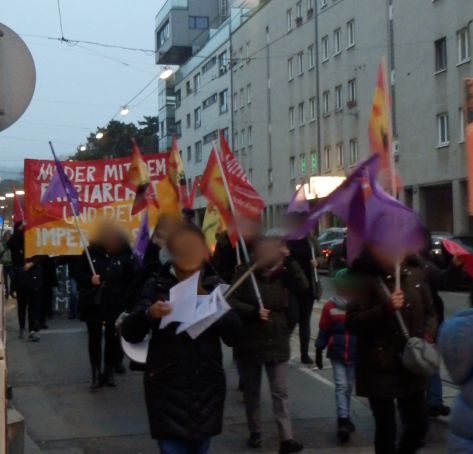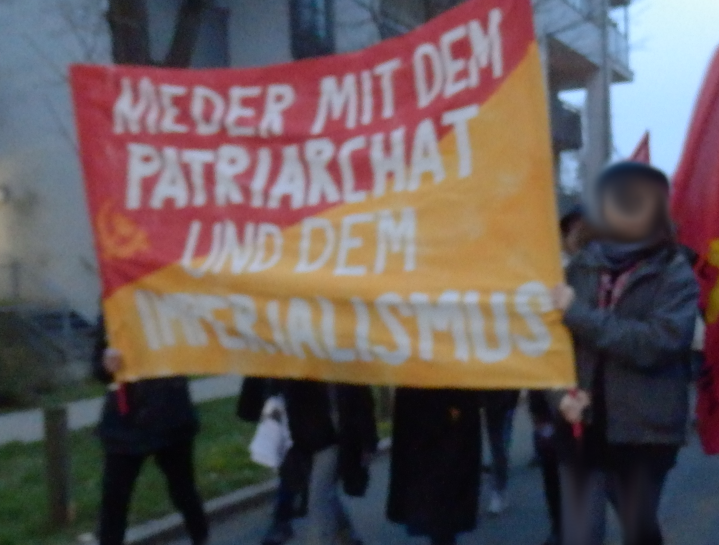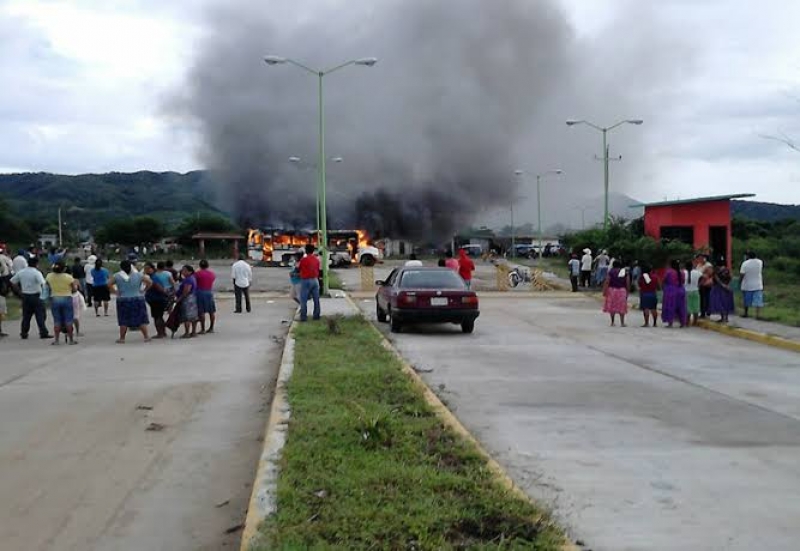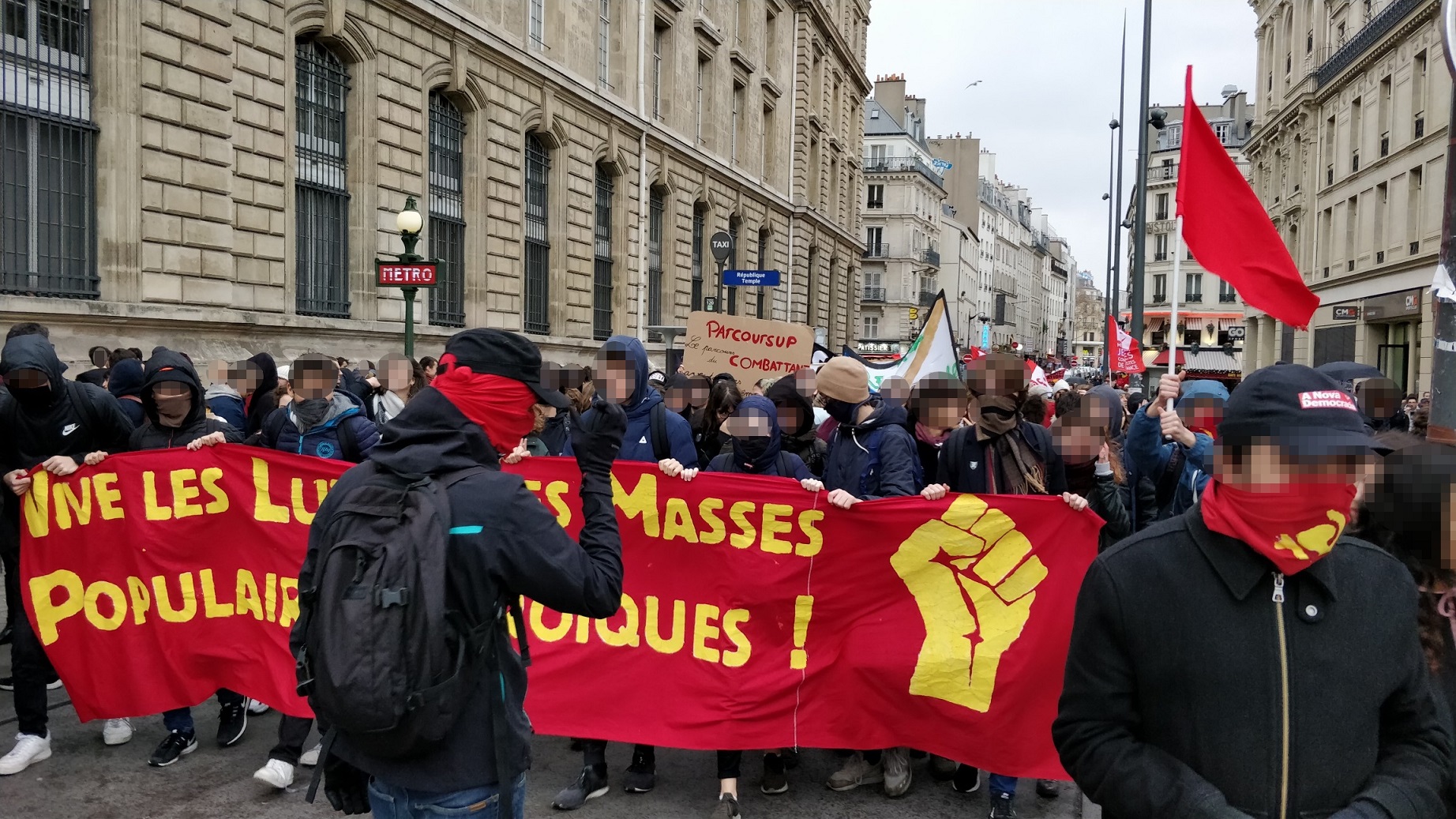Nachrichten
Nachrichten
- Details
- Category: Lateinamerika
Translated from an article of A Nova Democracia
Mexico: Active Election Boycott Prevents Polling in Town of Oaxaca
In the town of San Dionisio del Mar, in the region of Istmo de Tehuantepec (state of Oaxaca), there was an active boycott against the new municipal presidency election (equivalent to mayor) and prevented it from being held on 9 December. The boycott, approved at the People´s General Assembly, was made counting with fire and violent protests.
- Details
- Category: Lateinamerika
Third Meeting of Maoist Parties in Europe: Unification around Maoism advances
The Third Meeting of Marxist-Leninist-Maoist Parties and Organizations of Europe was held in November 2018. The Red Flag Committee (Germany), Maoist Communist Party of France (PCmF), Tjen Folket - Communist League (Norway), Red Flag Collective (Finland), Communist Party of Turkey / Marxist-Leninist and Peru People´s Movement (Reorganization Committee) were present.
From the Meeting, three joint resolutions were released: the first, Resolution on the Third Meeting of Marxist-Leninist-Maoist Parties and Organizations in Europe, the second Resolution of Class Solidarity with the People's Wars throughout the world, and the third Resolution for to defend the revolutionary political prisoners and prisoners of war and those disappeared by the reaction, published in the site Dem Volke Dienen. The documents in Portuguese can be read in the blog Serve the People.
The Resolutions affirm in a firm and enthusiastic way the commitment of Parties and Organizations to the ideological unity around Maoism and to fight for the Unified Maoist International Conference at the service of the Proletarian World Revolution. And they credit the advance in Europe to the initiative of the Latin American Maoist Parties and Organizations, which held its Fifth Meeting in 2016 - a milestone for the reunification of the world's communists, according to declarations signed by these parties.
"The successful conclusion of the III. Meeting marks another hallmark in the ongoing process of uniting in theoretical debate and joint action. On the basis of Marxism-Leninism-Maoism, principally Maoism, and in our ongoing struggle for ideological unity today, always implacably linked with the struggle against revisionism, we will increase our efforts in serving the Proletarian World Revolution." is the synthesis of the progress of the Meeting.
They also take their stand and send their greetings to political prisoners around the world qualifying them as inspiration. "Them holding high the position of our class, their the determination to not succumb to rotten betrayals and their unconciliable stance in the struggles that brought them into the sights of the enemy are a true inspiration for the revolutionaries of the world. "
Likewise, Parties and Organizations take a stand and greet the People´s Wars being led by Communist Parties throughout the world. "In the People’s Wars in Peru, India, Turkey and the Philippines, daring to fight and paying the toll with their precious blood, comrades stand in the thick of the struggle to sweep imperialism from the face of the earth. Their unwavering determination to achieve, with the principle and most developed form of class struggle which is People’s War, the new democratic revolution, to progress without interruption to the socialist revolution so to then march towards communism by means of cultural revolutions is a shining beacon for the international proletariat and the peoples of the world."

Translated from A Nova Democracia
- Details
- Category: Europa
One of the most controversial topics this year was climate protection, influenced by the Green Party who talked their mouths off with the topic. The extremely hot summer which was responsible for the great drought and under which agriculture had to bear a lot of pain, or even US President Donald Trump who allegedly drove the Federal Government to madness with his ignorance of this topic.
- Details
- Category: Europa
This weekend marked the 4th weekend of mass militant protest that currently has a firm grip on France. Since the eruption of what came to be known as the “Yellow Jacket” Movement with its initial mobilisation for the 17th of November the French proletariat has heroically continued to fight for its interests and withstood the attacks of the repression forces.
- Details
- Category: Lateinamerika
On the 30th of November, the commemorative festivity for our dear comrade José Sales Pimenta took place in Brazil with a huge mass turnout. CEBRASPO on this occasion published a video, that also depicts our comrade in his youth, agitating and engaging the police. Furthermore, we share the statement issued by the Indian intellectual Amit Bhattacharyya for this very occasion, who also contributed with several talks to the 5th Conference on bureaucratic capitalism that took place 2016 in Rio.
- Details
- Category: Europa
We mirror a homage to comrade Pierre published by French comrades on the 1st anniversary of our comrades death:
To our Comrade Pierre
It’s been a year since our Comrade Pierre has passed. And his presence on our side is lacking, that is certain. He would have been there in the Yellow Vests, he who had total faith in the power of the masses. He would have been on the blockades and at the very heart of the revolt because, despite his advanced age, nothing scared him. He would have said “tear gas stings a little at first but we get used to it quickly! “. He would have supported faultlessly the just revolt of today. He would have gone from demonstrations to demonstrations, from blockages to blockades. He would have fought openly, “in front the masses” as he often said, the reactionary elements present in the movement. He, who had been politicized by May 68, would have been proud to see this revolt of the working class 50 years later.
The young Comrades who have not known our Comrade Pierre too well must be inspired by the energy he has transmitted to us. An unfailing and permanent commitment to the heart of the class struggle in close connection with the masses. An absolute confidence in the popular masses to recognize their friends and fight their enemies. Our Comrade Pierre had faith in the ability of the masses to revolt, to learn in a very short time the ways of the class struggle, as happened around him on many occasions.
This personal commitment and trust in the masses do not come from nowhere. This stems from the ideology that our Comrade Pierre had made his own: Marxism-Leninism-Maoism. That is the ideology of the working class around the world, the ideology of the international proletariat. All his life he has sought the correct line, seeking to deepen his knowledge of ideology, not only by studying the theory but especially by putting it to the test of practice; through a long and tireless path, to gather around him new comrades around a correct line, the line of reconstruction of a genuine Communist Party, a Maoist Communist Party.
In doing so, he swam all his life against the tide, confronted the reactionaries, participated at the international level in the reconstruction of the movement, organized young people despite the great age difference, showing them the way by going where the working class lives, works and wrestles: on the picket lines, factory occupations, at the very heart of the 2005 suburbs revolt, on the markets of the working-class neighborhoods, in the homes of young workers, in immigrant workers, in occupied dwellings…
Everywhere, in all meetings, he supported the need to build an authentic Communist Party, a Maoist Communist Party, developing in the heat of the class struggle, preparing for the People’s War, an extended process leading to the victory of the working class and the masses on the imperialist bourgeoisie. To the international comrades he met, he repeated with determination: “Build the Party!”
Today, in the revolt of the Yellow Vests, he would have been the first to go to proclaim the necessity of the Party so that this revolt turns into a revolution. And of course he would have been right.
Despite his cruel absence, this task is carried on by what he called “the succession”. Yes Comrade Pierre, every Comrade of the Party is well aware of the need to continue the fight of a lifetime: to affirm in theory and in practice the necessity of the Communist Party of today, the Maoist Communist Party. “Do not put the flag in your pocket ” as you said. Whatever the circumstances, whatever the adversity, there is only one way for the liberation of our class – and consequently of all humanity – the proletarian revolution. We therefore assume our role, in the current revolt of the Yellow Vests of course, but also in its continuity, which will necessarily take many other forms.
Camarade Pierre, présent!
Let’s continue building the Maoist Communist Party in the heat of the class struggle in close connection with the masses!
Long live Marxism-Leninism-Maoism, the ideology that guides our daily action!
- Details
- Category: Lateinamerika
On November 28 there was a new mobilization of students in several cities of the country. The demand remains the same: more funding for public Higher Education Institutions (HEIs). The State's response also remains the same: to defend its education project as a business of the big capital and imperialism, which can be summarized as follows: 1- Gradual de-financing of HEIs; 2- Compelling them to self-finance by raising enrollments, selling research to multinationals and large companies, selling cultural and sports services to the middle class, and ending the support programs for the popular classes within the University; 3- Promote educational credits, strengthening the Icetex with state resources and with loans from the World Bank, promoting that students and their families get indebted with educational loans to access higher education; 4- Increase the level of demand for admission to public universities, with expensive registration pins and more difficult admission tests, which leaves the poorest young people who come from public schools with almost no possibilities.
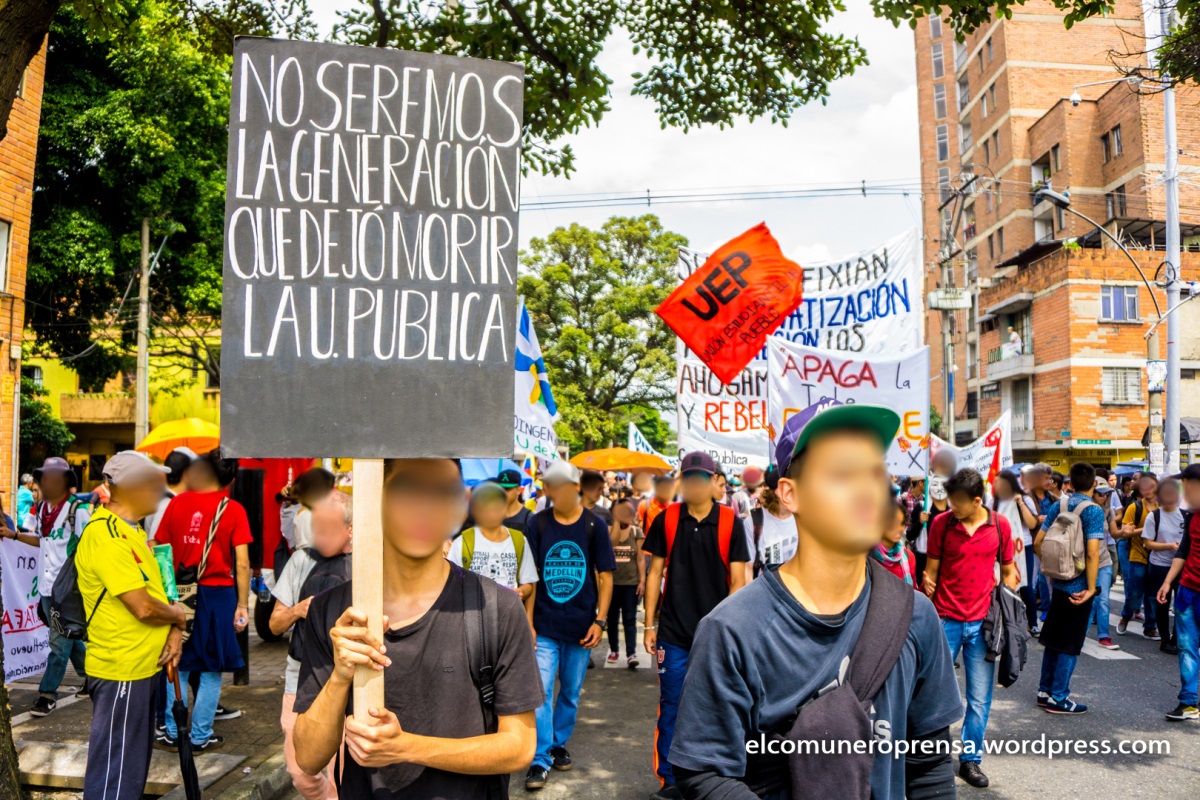
This state plan, applied little by little since the 90s, has led public universities to an unprecedented crisis: some have been applied bankruptcy law, others with buildings that are falling apart, dismantle the university welfare for popular sectors (residences, restaurants and free transportation), collection of registration pins with values between $ 50,000 and $ 120,000, hiring professors per hour chair, minimum enrollment above $ 500,000 / semester in large amount of public HEI, collection of outputs field to students, among many other expressions that affect all students, but especially the poorest, because every year there are fewer guarantees for young people from working and peasant families can access and maintain public university. And while the poorest young people are gradually excluded from public universities, the middle class (strata 3, 4 and 5) are now the sector to which the public university is directed, since they are the children of families with the ability to pay tuition fees, currently between $ 1,000,000 and $ 3,000,000 per semester, and continue to rise.
Faced with this situation, the last governments (Santos and now Duque), continue to deepen the plan: not giving importance for public universities and greater budget for Icetex (educational credits), but now they created a new ingredient: 5- Strengthening of most prestigious private universities` programs, through programs such as the former "Ser Pilo Paga" or the new "Generation E", which are scholarships for the best secondary school students, programs that annually only favor less than 2% of all high school graduates 1 , 2 and 3, and that are resources that in more than 80% end up in private ones. A great business in which private universities, banks and Icetex (which pays very high interest to the World Bank) win, and loses the working people, the children of workers, peasants and the middle classes, for whom, with the gradual dismantling of the public university, there is only one option: borrow to study.
This year, facing the alarm of several rectors of public universities, that the resources not even did reach enough to finish the year, unleashed an ample student and teacher movement that already completes more than a month, and in some cities more than two months, with weekly mobilizations and gradual increase in combativity and confrontations with the police. The past November 28 was not the exception, after the march, students of several universities decided to make a blockade of Barranquilla Street, outside the University of Antioquia (UdeA), to exert greater pressure on the State. Before the repression of the riot police, the students responded with stones, sticks, explosives and Molotov cocktails. Below are photographs of the march in the city of Medellín and the confrontation with the police in UdeA.
Translated from El Comunero
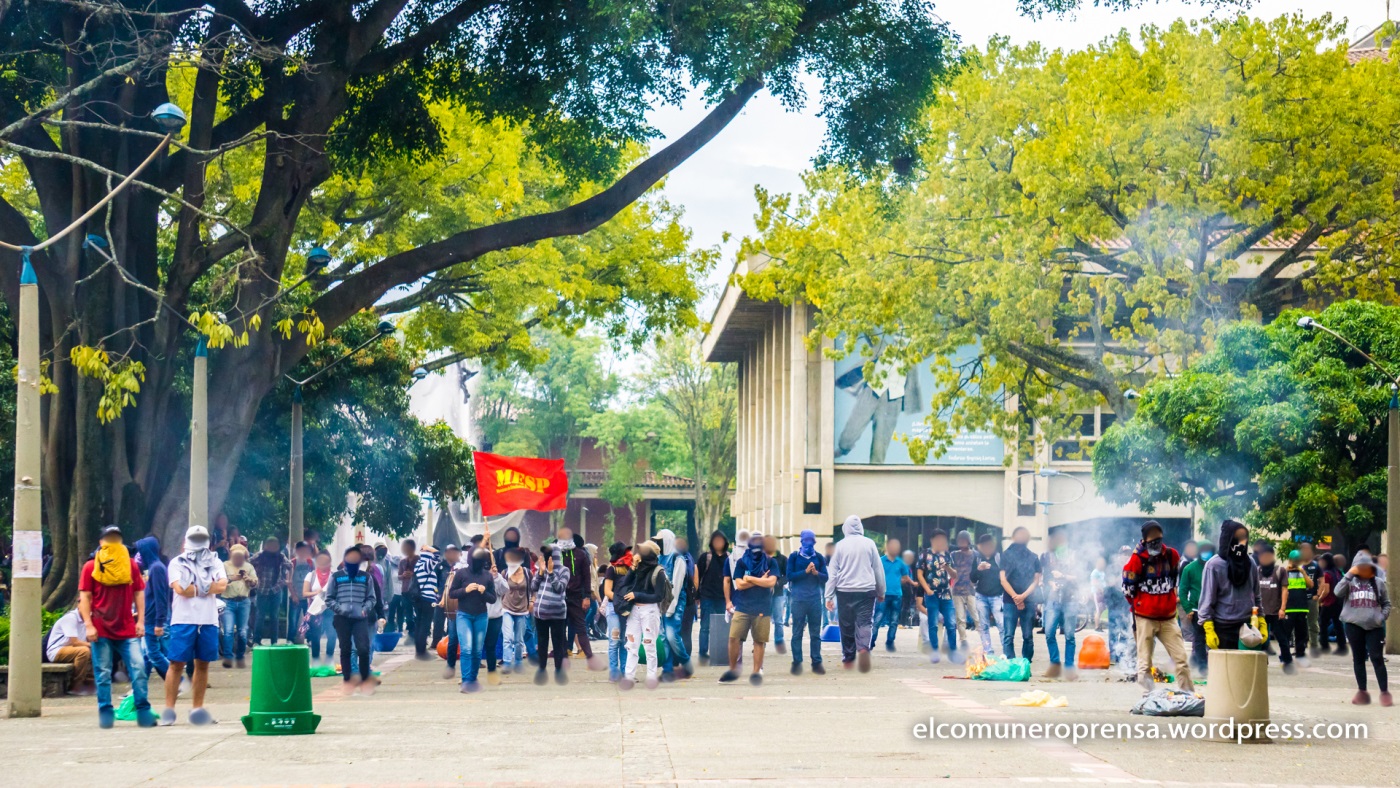
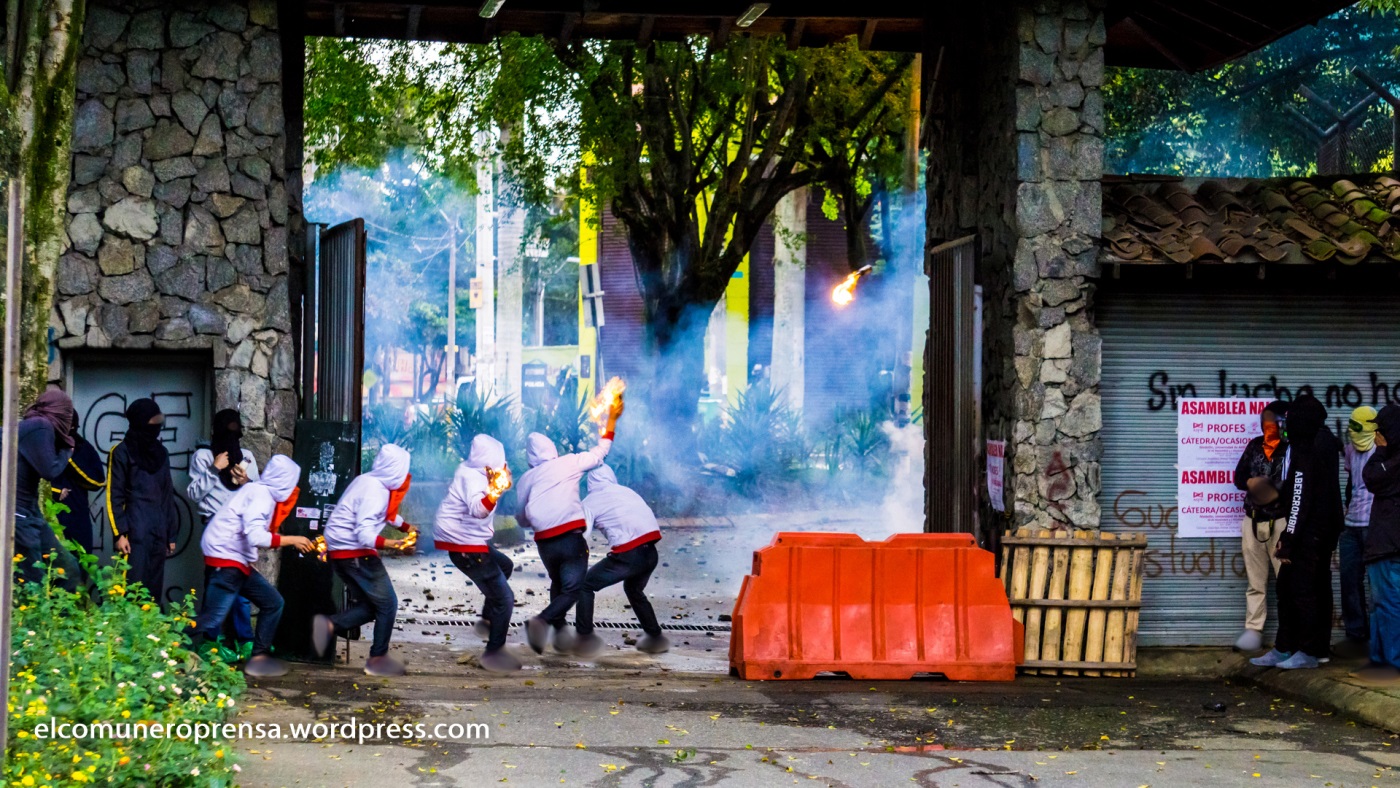
- Details
- Category: Europa
We forward the publication from Antifascist Action on the ocasion of the 25th of November.
Around the world, women used the 25th of November, the International Day against Violence against Women, to carry their justified protest and struggle to the streets, in Austria as well. Editors of the „Antifaschistische Aktion – Infoblatt“ took part in this year’s demonstration in Vienna. It was a very lively and loud demonstration, that attracted much attention. The day before, various actions and protests were set against a march of the clerical-fascist abortion opponents in Vienna.
Positively noticed was the internationalist demonstration, involving many migrants and slogans in different languages. This reflects the intensified oppression of the migrant women, who are particularly affected by the attacks of the ruling class. Especially strong was that the demonstration was attended by a strong contingent of red women, wearing a banner reading „Down with Patriarchy and Imperialism.“ These were noticeable by a good, combative mood and they contributed many slogans in the demonstration, which were then shouted by large parts of the demonstration. Slogans against the 12-hours working day and Patriarchy were demonstrating, that violence against women is not only individual, but is organized by the state and is directed against all women. Patriarchy is expressed thousands of times a day in the „own four walls“, but above all it is a harsh instrument of domination against the masses of women.
The main purpose of this demonstration was to demonstrate that, in addition to the legitimate and necessary protest against the attacks of the government and against the brutal individual violence against women, there must be an intensified struggle against patriarchy. An activist of the Red Women’s Committee Austria, said in a conversation to us: „Thousands of women have participated in the protests against the government in the last year, against the 12–hours working day, against the EU-Alliance, … that shows that many women already today don‘t believe the lies of „weak“ and „unpolitical“ women. The pioneers of the proletarian women’s movement in Austria have also shown this: they have consciously also made the lead of the revolutionary struggle. This year marks the 100 anniversary of the founding of the Communist Party Austria. Above all, we must learn from the experiences of the proletarian women’s movement and use the 25th of November to better understand proletarian feminism, the revolutionary line in the women’s movement, and put it into practice. For only the revolutionary struggle will drive forward the emancipation of women and support the creation of a Communist Party. „
At the demonstration a leaflet of the Red Women’s Committees Austria was distributed, which can be read as text already online: Down with Patriarchy! Get organized in the Red Women’s Committees!
The numerous slogans that contributed to a combative mood at the demonstration and were shouted together by large parts of the demonstration, also demonstrated the need to fight against the fragmentation of the women’s movement in Austria. The fight against patriarchy and imperialism, as well emphasized in the above-mentioned leaflet, means „not ‚cooking everyones own soup‘ regionally. Learning from each other’s experience and mistakes, bringing the struggles together and putting them on a common base, will make the development of a women’s movement in the service of the revolution even more powerful. „
Above all, the red women, who have already united on the basis of Proletarian Feminism, showed that there is already a force in the women’s movement in Austria that takes up this struggle. For all conscious feminists and red women, this demonstration should also be an occasion to take up even more the mobilization of women for the struggle not only for their daily demands, but also against patriarchy and imperialism. This year’s 25th of November should be a starting point to take on these tasks even more decisively in the upcoming actions and demonstrations and put them into practice.
We would like to record here two slogans, that have been distributed on the demo, for the upcoming struggles:
Against Imperialism and Patriarchy!
Proletarian Feminism for Communism!
